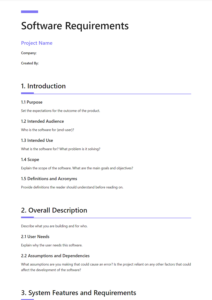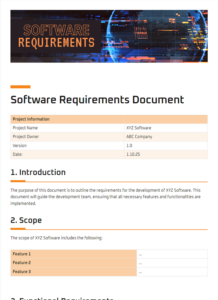A system requirements document (SRD) is a critical artifact in the software development lifecycle. It defines the functional and non-functional requirements that a system must meet to be successful. Without a clear and well-defined SRD, it is difficult to develop a system that meets the needs of users and stakeholders.
There are many different ways to create a SRD, but one common approach is to use a template. A template provides a structured framework for capturing and organizing requirements. It can help ensure that all of the necessary information is included in the SRD and that it is presented in a clear and concise manner.
What to Include in a System Requirements Document
The specific contents of a SRD will vary depending on the project and the organization, but there are some general elements that should be included in most SRDS:
- Introduction: This section provides an overview of the system and its purpose. It should include a statement of the problem that the system is intended to solve, as well as the goals and objectives of the system.
- Scope: This section defines the boundaries of the system. It should identify the system’s components, interfaces, and data.
- Requirements: This section defines the functional and non-functional requirements that the system must meet. Functional requirements describe the specific tasks that the system must be able to perform, while non-functional requirements describe the overall characteristics of the system, such as its performance, reliability, and security.
- Validation criteria: This section describes how the system will be tested to ensure that it meets the requirements.
- Glossary: This section defines the terms and abbreviations that are used in the SRD.
Benefits of Using a System Requirements Document Template
There are many benefits to using a SRD template, including:
- Improved communication: A template can help ensure that all stakeholders are using the same language and understanding the requirements in the same way.
- Reduced risk: A template can help identify potential risks and issues early in the development process.
- Increased efficiency: A template can help streamline the requirements gathering and analysis process.
- Improved quality: A template can help ensure that the SRD is complete, accurate, and consistent.
Conclusion
A system requirements document (SRD) is a critical artifact in the software development lifecycle. It defines the functional and non-functional requirements that a system must meet to be successful. Using a SRD template can help ensure that the SRD is complete, accurate, and consistent. This can lead to improved communication, reduced risk, increased efficiency, and improved quality.
There are many different SRD templates available, so it is important to choose one that is appropriate for the project and the organization. Once a template has been selected, it can be customized to meet the specific needs of the project.


